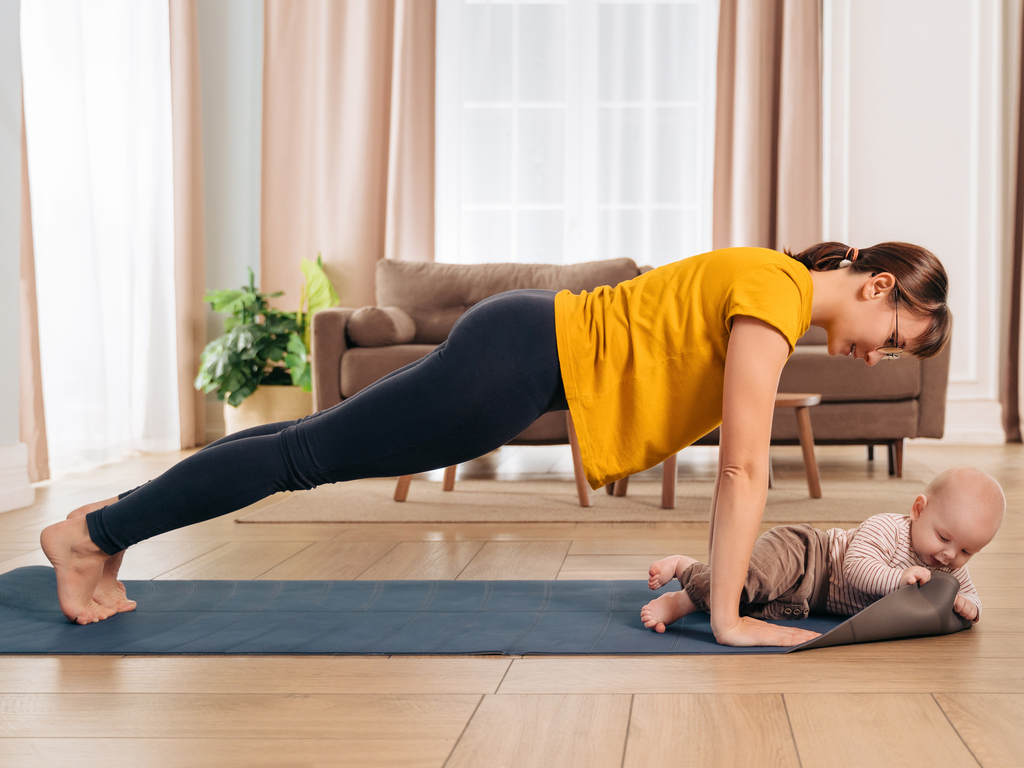Four Things to Consider Before Exercising Postpartum


Whether you had a natural birth or C-Section, re-engaging your core and getting your breath back is key for getting back into fitness. It’s often harder for women to find their abdominal muscles after a C-section because the area remains numb from the operation.
It’s recommended you start with low-intensity ab exercises to ensure your brain connects to your core properly. Focus on bracing your transverse abdominis during these workouts. This is the deep layer of ab muscle.
Place your fingers on your abs and feel if the muscles contract to know you’re engaging your core. It takes some getting used to, but this step helps reinforce the brain-muscle connection. You can start more intense exercises when you feel the muscles contract more.
The abdominal wall gets stretched and weakened during pregnancy as the baby puts pressure on the linea alba. This is the tissue that connects the two halves of the rectus abdominis – the ab muscle in front of your belly. That weakness could separate your abs and lead to diastasis recti.
Having diastasis recti means that you must work harder to properly manage pressure on your abs. Pressure generally increases when you brace yourself, move, and hold your breath. Some exercises could be too demanding on your body if you have diastasis recti.
Ease back into lifting weights because weights can make abs separate more, especially if you hold your breath when lifting. Focus on strengthening your deeper core at first to build back the tension so you can deal with challenging exercises.
The pelvic floor muscles are responsible for blood flow and sexual function. They also prevent incontinence. Some women experience pelvic floor dysfunction after giving birth. Some exercises make the problem worse if you aren’t careful.
If you notice urinary leaking or extra pressure when exercising, these indicate you are pushing your pelvic floor too hard. Reduce the impact and avoid exercises like running, jumping, and lifting. Focus on your breathing and building your pelvic floor and core muscles back up.
Pregnancy can alter the curvature of your back by shifting weight forward. This can cause some postpartum muscle imbalances. Some women deal with tightness in the hips and back, as well as trouble with engaging their abs and glutes.
Focus on building mobility in your hips and improving ab and glute strength. This helps to protect your lower back, which is helpful for new parents given how much you’ll be carrying your baby around all day.
New parents should focus on getting better and feeling stronger after giving birth, not on losing weight and getting back into shape. Recovering from childbirth, the fatigue of taking care of a new baby, and hormonal changes all impact your energy levels and your ability to exercise.
I'm a fully qualified Beautician and a practitioner of Non-Surgical Cosmetic Procedures. Having worked in the beauty industry since 2011 I have gained a lot of experience and gone on to become a published expert in a wide range of matters concerning health, beauty and nutrition.
Online Assets LTD t/a Gabbro Health
Registered office: 20-22 Wenlock Road London N1 7GU
Company Number: 10517403
VAT Number: 257763859
As an Amazon Associate, ebay Partner Network partner and a publisher member of third party affiliate platforms Online Assets LTD t/a Gabbro Health earns from qualifying purchases.
| Cookie | Duration | Description |
|---|---|---|
| cookielawinfo-checbox-analytics | 11 months | This cookie is set by GDPR Cookie Consent plugin. The cookie is used to store the user consent for the cookies in the category "Analytics". |
| cookielawinfo-checbox-functional | 11 months | The cookie is set by GDPR cookie consent to record the user consent for the cookies in the category "Functional". |
| cookielawinfo-checbox-others | 11 months | This cookie is set by GDPR Cookie Consent plugin. The cookie is used to store the user consent for the cookies in the category "Other. |
| cookielawinfo-checkbox-necessary | 11 months | This cookie is set by GDPR Cookie Consent plugin. The cookies is used to store the user consent for the cookies in the category "Necessary". |
| cookielawinfo-checkbox-performance | 11 months | This cookie is set by GDPR Cookie Consent plugin. The cookie is used to store the user consent for the cookies in the category "Performance". |
| viewed_cookie_policy | 11 months | The cookie is set by the GDPR Cookie Consent plugin and is used to store whether or not user has consented to the use of cookies. It does not store any personal data. |
